
The Siberian stonechat or Asian stonechat is a recently validated species of the Old World flycatcher family (Muscicapidae). Like the other thrush-like flycatchers, it was often placed in the Turdidae in the past. It breeds in the East Palearctic including in easternmost Europe and winters in the Old World tropics.
Charles Gald Sibley was an American ornithologist and molecular biologist. He had an immense influence on the scientific classification of birds, and the work that Sibley initiated has substantially altered our understanding of the evolutionary history of modern birds.

The northern shoveler, known simply in Britain as the shoveler, is a common and widespread duck. It breeds in northern areas of Europe and across the Palearctic and across most of North America, wintering in southern Europe, the Indian subcontinent, Southeast Asia, Central, the Caribbean, and northern South America. It is a rare vagrant to Australia. In North America, it breeds along the southern edge of Hudson Bay and west of this body of water, and as far south as the Great Lakes west to Colorado, Nevada, and Oregon.

The yellow-browed warbler is a leaf warbler which breeds in the east Palearctic. This warbler is strongly migratory and winters mainly in tropical South Asia and South-east Asia, but also in small numbers in western Europe. Like the rest of Phylloscopidae, it was formerly included in the Old World warbler assemblage.

The common gull or sea mew is a medium-sized gull that breeds in the Palearctic. The closely related short-billed gull is sometimes included in this species, which may be known collectively as "mew gull". Many common gulls migrate further south in winter. There are differing accounts as to how the species acquired its vernacular name.

The great cormorant, known as the black shag or kawau in New Zealand, formerly also known as the great black cormorant across the Northern Hemisphere, the black cormorant in Australia, and the large cormorant in India, is a widespread member of the cormorant family of seabirds. The genus name is Latinised Ancient Greek, from φαλακρός and κόραξ, and carbo is Latin for "charcoal".

The grey partridge, also known as the gray-legged partridge, English partridge, Hungarian partridge, or hun, is a gamebird in the pheasant family Phasianidae of the order Galliformes, gallinaceous birds. The scientific name is the Latin for "partridge", and is itself derived from Ancient Greek perdix.

The squacco heron is a small heron, 44–47 cm long, of which the body is 20–23 cm (8–9 in), with 80–92 cm wingspan. It is of Old World origins, breeding in southern Europe and the Greater Middle East.
The West Midland Bird Club is the UK's largest regional ornithological society. It has been serving birdwatchers and ornithologists in the four English counties of Staffordshire, Warwickshire, Worcestershire and the Metropolitan West Midlands, with lectures, field trips, research, a bulletin and an annual report, since 1929. It is a registered charity in England and Wales, number 213311.

The pectoral sandpiper is a small, migratory wader that breeds in North America and Asia, wintering in South America and Oceania. It eats small invertebrates. Its nest, a hole scraped in the ground and with a thick lining, is deep enough to protect its four eggs from the cool breezes of its breeding grounds. The pectoral sandpiper is 21 cm (8.3 in) long, with a wingspan of 46 cm (18 in).
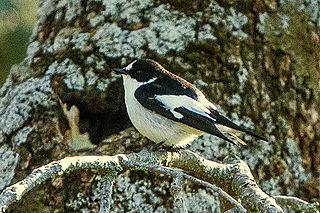
The Atlas pied flycatcher or Atlas flycatcher is a bird in an Old World flycatcher family, one of the four species of Western Palearctic black-and-white flycatchers; it is endemic as a breeding species to North-west Africa.
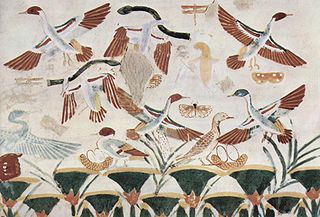
The following is a timeline of ornithology events:
Wild Flowers Worth Knowing is a book published in 1917 as a result of an adaptation by Asa Don Dickinson of Neltje Blanchan's earlier work Nature's Garden (1900).

Nature's Garden: An Aid to Knowledge of our Wild Flowers and their Insect Visitors (1900), republished as Wild Flowers: An Aid to Knowledge of our Wild Flowers and their Insect Visitors (1901), is a book written by nature writer Neltje Blanchan and published by Doubleday, Page & Company. In order to aid the amateur botanist, it used color to classify flowers, noting that this made it easier for novices to identify specimens, and that insects also used color to identify plants. The book also explored the relationship between flowers and the insects that feed on their nectar, using rather anthropomorphic language, and discussed scientific questions of the time, such as Sprengel's theory that orchids produce no nectar. Her description of the flowers also referred to relevant poetry and folklore. Unlike her book Bird Neighbors, the photographs were taken directly from nature.

Bird Neighbors, published in 1897, was the first major work by nature writer Neltje Blanchan. The book combined scientific data with color illustrations, accessible language, and personal experience reflecting Blanchan's joy in nature. In his introduction, naturalist John Burroughs praised it as "reliable" as well as "written in a vivacious strain by a real bird lover."

The pink robin is a small passerine bird native to southeastern Australia. Its natural habitats are cool temperate forests of far southeastern Australia. Like many brightly coloured robins of the family Petroicidae, it is sexually dimorphic. Measuring 13.5 cm (5.3 in) in length, the robin has a small, thin, black bill, and dark brown eyes and legs. The male has a distinctive white forehead spot and pink breast, with grey-black upperparts, wings and tail. The belly is white. The female has grey-brown plumage. The position of the pink robin and its Australian relatives on the passerine family tree is unclear; the Petroicidae are not closely related to either the European or American robins, but appear to be an early offshoot of the Passerida group of songbirds.

The black-sided robin, also known as the pied robin, is a species of bird in the family Petroicidae. It is widespread throughout New Guinea. Its natural habitat is subtropical or tropical moist lowland forests.
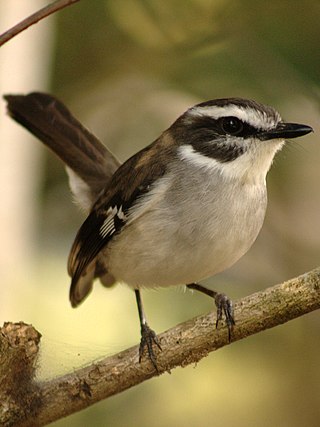
The white-browed robin is a species of bird in the family Petroicidae. It is endemic to north-eastern Australia. Its natural habitats are forest, woodland and scrub, often near water. It formerly included the buff-sided robin as a subspecies.
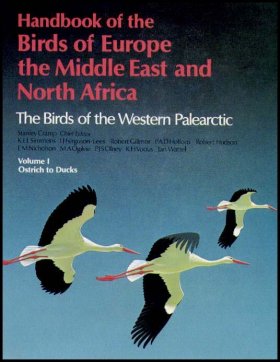
The Birds of the Western Palearctic is a nine-volume ornithological handbook covering the birds of the western portion of the Palearctic zoogeographical region.
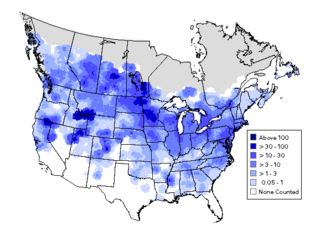
A bird atlas is an ornithological work that attempts to provide information on the distribution, abundance, long-term change as well as seasonal patterns of bird occurrence and make extensive use of maps. They often involve a large numbers of volunteers to cover a wide geographic area and the methods used are standardized so that the studies can be continued in the future and the results remain comparable. In some cases the species covered may be restricted to those that breed or are resident. Migration atlases on the other hand cover migratory birds depict maps showing summaries of ringing and recoveries.
















